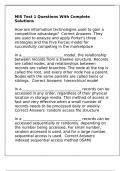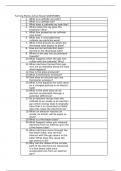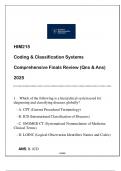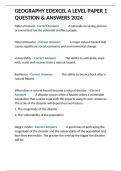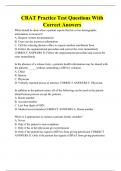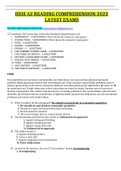ALEVELPAPERZZ2024
A-level
MATHEMATICS
7357/2
Paper 2
Mark scheme
June 2024
Version: 1.0 Final
, MARK SCHEME – A-LEVEL MATHEMATICS – 7357/2 – JUNE 2024
Mark scheme instructions to examiners
General
The mark scheme for each question shows:
• the marks available for each part of the question
• the total marks available for the question
• marking instructions that indicate when marks should be awarded or withheld including the principle
on which each mark is awarded. Information is included to help the examiner make his or her
judgement and to delineate what is creditworthy from that not worthy of credit
• a typical solution. This response is one we expect to see frequently. However credit must be given on
the basis of the marking instructions.
If a student uses a method which is not explicitly covered by the marking instructions the same
principles of marking should be applied. Credit should be given to any valid methods. Examiners should
seek advice from their senior examiner if in any doubt.
Key to mark types
M mark is for method
R mark is for reasoning
A mark is dependent on M marks and is for accuracy
B mark is independent of M marks and is for method and accuracy
E mark is for explanation
F follow through from previous incorrect result
Key to mark scheme abbreviations
CAO correct answer only
CSO correct solution only
ft follow through from previous incorrect result
‘their’ indicates that credit can be given from previous incorrect result
AWFW anything which falls within
AWRT anything which rounds to
ACF any correct form
AG answer given
SC special case
OE or equivalent
NMS no method shown
PI possibly implied
sf significant figure(s)
dp decimal place(s)
3
, MARK SCHEME – A-LEVEL MATHEMATICS – 7357/2 – JUNE 2024
AS/A-level Maths/Further Maths assessment objectives
AO Description
AO1.1a Select routine procedures
AO1 AO1.1b Correctly carry out routine procedures
AO1.2 Accurately recall facts, terminology and definitions
AO2.1 Construct rigorous mathematical arguments (including proofs)
AO2.2a Make deductions
AO2.2b Make inferences
AO2
AO2.3 Assess the validity of mathematical arguments
AO2.4 Explain their reasoning
AO2.5 Use mathematical language and notation correctly
AO3.1a Translate problems in mathematical contexts into mathematical processes
AO3.1b Translate problems in non-mathematical contexts into mathematical processes
AO3.2a Interpret solutions to problems in their original context
AO3.2b Where appropriate, evaluate the accuracy and limitations of solutions to problems
AO3 AO3.3 Translate situations in context into mathematical models
AO3.4 Use mathematical models
AO3.5a Evaluate the outcomes of modelling in context
AO3.5b Recognise the limitations of models
AO3.5c Where appropriate, explain how to refine models
4
, MARK SCHEME – A-LEVEL MATHEMATICS – 7357/2 – JUNE 2024
Examiners should consistently apply the following general marking principles:
No Method Shown
Where the question specifically requires a particular method to be used, we must usually see
evidence of use of this method for any marks to be awarded.
Where the answer can be reasonably obtained without showing working and it is very unlikely that the
correct answer can be obtained by using an incorrect method, we must award full marks. However,
the obvious penalty to students showing no working is that incorrect answers, however close, earn no
marks.
Where a question asks the student to state or write down a result, no method need be shown for full
marks.
Where the permitted calculator has functions which reasonably allow the solution of the question
directly, the correct answer without working earns full marks, unless it is given to less than the
degree of accuracy accepted in the mark scheme, when it gains no marks.
Otherwise we require evidence of a correct method for any marks to be awarded.
Diagrams
Diagrams that have working on them should be treated like normal responses. If a diagram has been
written on but the correct response is within the answer space, the work within the answer space
should be marked. Working on diagrams that contradicts work within the answer space is not to be
considered as choice but as working, and is not, therefore, penalised.
Work erased or crossed out
Erased or crossed out work that is still legible and has not been replaced should be marked. Erased
or crossed out work that has been replaced can be ignored.
Choice
When a choice of answers and/or methods is given and the student has not clearly indicated which
answer they want to be marked, mark positively, awarding marks for all of the student’s best attempts.
Withhold marks for final accuracy and conclusions if there are conflicting complete answers or when an
incorrect solution (or part thereof) is referred to in the final answer.
5
, MARK SCHEME – A-LEVEL MATHEMATICS – 7357/2 – JUNE 2024
Q Marking instructions AO Marks Typical solution
1 Ticks 4th box 1.2 B1
( x + 1)2 + ( y + 2 )2 =
36
Question 1 Total 1
Q Marking instructions AO Marks Typical solution
2 Circles 3rd answer 2.2a B1 125
Question 2 Total 1
Q Marking instructions AO Marks Typical solution
3 Ticks 1st box 1.1b B1 { x : x < 1} { x : x > 4}
Question 3 Total 1
Q Marking instructions AO Marks Typical solution
4 Takes logs of both sides to
same base 1.1b B1
( )
log 5 5 x −2 = log 5 71570
PI by x − 2 =log 5 71570 1570 log 5 7
x−2 =
n
Uses log A = n log A x= 2 + 1570 log 5 7
1.1a M1 = 1900.23
PI by x − 2 =log 5 71570
Completes a reasoned
argument using logarithms to 2.1 R1
obtain AWRT 1900
Question 4 Total 3
6
A-level
MATHEMATICS
7357/2
Paper 2
Mark scheme
June 2024
Version: 1.0 Final
, MARK SCHEME – A-LEVEL MATHEMATICS – 7357/2 – JUNE 2024
Mark scheme instructions to examiners
General
The mark scheme for each question shows:
• the marks available for each part of the question
• the total marks available for the question
• marking instructions that indicate when marks should be awarded or withheld including the principle
on which each mark is awarded. Information is included to help the examiner make his or her
judgement and to delineate what is creditworthy from that not worthy of credit
• a typical solution. This response is one we expect to see frequently. However credit must be given on
the basis of the marking instructions.
If a student uses a method which is not explicitly covered by the marking instructions the same
principles of marking should be applied. Credit should be given to any valid methods. Examiners should
seek advice from their senior examiner if in any doubt.
Key to mark types
M mark is for method
R mark is for reasoning
A mark is dependent on M marks and is for accuracy
B mark is independent of M marks and is for method and accuracy
E mark is for explanation
F follow through from previous incorrect result
Key to mark scheme abbreviations
CAO correct answer only
CSO correct solution only
ft follow through from previous incorrect result
‘their’ indicates that credit can be given from previous incorrect result
AWFW anything which falls within
AWRT anything which rounds to
ACF any correct form
AG answer given
SC special case
OE or equivalent
NMS no method shown
PI possibly implied
sf significant figure(s)
dp decimal place(s)
3
, MARK SCHEME – A-LEVEL MATHEMATICS – 7357/2 – JUNE 2024
AS/A-level Maths/Further Maths assessment objectives
AO Description
AO1.1a Select routine procedures
AO1 AO1.1b Correctly carry out routine procedures
AO1.2 Accurately recall facts, terminology and definitions
AO2.1 Construct rigorous mathematical arguments (including proofs)
AO2.2a Make deductions
AO2.2b Make inferences
AO2
AO2.3 Assess the validity of mathematical arguments
AO2.4 Explain their reasoning
AO2.5 Use mathematical language and notation correctly
AO3.1a Translate problems in mathematical contexts into mathematical processes
AO3.1b Translate problems in non-mathematical contexts into mathematical processes
AO3.2a Interpret solutions to problems in their original context
AO3.2b Where appropriate, evaluate the accuracy and limitations of solutions to problems
AO3 AO3.3 Translate situations in context into mathematical models
AO3.4 Use mathematical models
AO3.5a Evaluate the outcomes of modelling in context
AO3.5b Recognise the limitations of models
AO3.5c Where appropriate, explain how to refine models
4
, MARK SCHEME – A-LEVEL MATHEMATICS – 7357/2 – JUNE 2024
Examiners should consistently apply the following general marking principles:
No Method Shown
Where the question specifically requires a particular method to be used, we must usually see
evidence of use of this method for any marks to be awarded.
Where the answer can be reasonably obtained without showing working and it is very unlikely that the
correct answer can be obtained by using an incorrect method, we must award full marks. However,
the obvious penalty to students showing no working is that incorrect answers, however close, earn no
marks.
Where a question asks the student to state or write down a result, no method need be shown for full
marks.
Where the permitted calculator has functions which reasonably allow the solution of the question
directly, the correct answer without working earns full marks, unless it is given to less than the
degree of accuracy accepted in the mark scheme, when it gains no marks.
Otherwise we require evidence of a correct method for any marks to be awarded.
Diagrams
Diagrams that have working on them should be treated like normal responses. If a diagram has been
written on but the correct response is within the answer space, the work within the answer space
should be marked. Working on diagrams that contradicts work within the answer space is not to be
considered as choice but as working, and is not, therefore, penalised.
Work erased or crossed out
Erased or crossed out work that is still legible and has not been replaced should be marked. Erased
or crossed out work that has been replaced can be ignored.
Choice
When a choice of answers and/or methods is given and the student has not clearly indicated which
answer they want to be marked, mark positively, awarding marks for all of the student’s best attempts.
Withhold marks for final accuracy and conclusions if there are conflicting complete answers or when an
incorrect solution (or part thereof) is referred to in the final answer.
5
, MARK SCHEME – A-LEVEL MATHEMATICS – 7357/2 – JUNE 2024
Q Marking instructions AO Marks Typical solution
1 Ticks 4th box 1.2 B1
( x + 1)2 + ( y + 2 )2 =
36
Question 1 Total 1
Q Marking instructions AO Marks Typical solution
2 Circles 3rd answer 2.2a B1 125
Question 2 Total 1
Q Marking instructions AO Marks Typical solution
3 Ticks 1st box 1.1b B1 { x : x < 1} { x : x > 4}
Question 3 Total 1
Q Marking instructions AO Marks Typical solution
4 Takes logs of both sides to
same base 1.1b B1
( )
log 5 5 x −2 = log 5 71570
PI by x − 2 =log 5 71570 1570 log 5 7
x−2 =
n
Uses log A = n log A x= 2 + 1570 log 5 7
1.1a M1 = 1900.23
PI by x − 2 =log 5 71570
Completes a reasoned
argument using logarithms to 2.1 R1
obtain AWRT 1900
Question 4 Total 3
6



